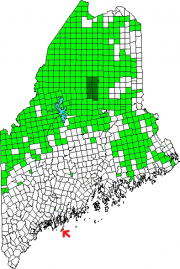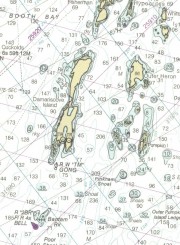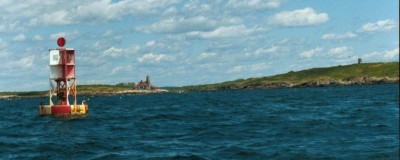By 1605 the English were fishing near the island. In 1622 when the Pilgrims were near starvation in the Plymouth Colony, supplies from Damariscove Island prevented complete disaster.
Based on Dorothy Simpson’s account, the group of islands (now known as Fisherman’s, Outer and Inner Heron, Big and LittleWhite) that included Damariscove were known in the 17th century as Damarill’s Isles, since Humphrey Damarill owned them. Considering the extensive, narrow inlet at its southern end, it is a short leap to assume that it may have been called “Damerill’s Cove,” and later the island, Damariscove.
In 1675, a year of many Indian raids, people from nearby coastal settlements attempted to flee to Monhegan, but diverted to Damariscove because of unfriendly winds. There the 300 or so homeless folks watched the smoke from their burning villages. Luckily for them, the Indians did not attack the island.
On September 5, 1812, residents watched the British frigate Boxer and the American ship Enterprise engage in a fierce battle that left both captains dead and the British vessel in American hands.
At one time or another home to a trading post, dairy farms, an ice business, a population supporting a small school, and a Coast Guard Station, the Island is currently uninhabited and owned by the Nature Conservancy. One-quarter of a mile wide and 1.7 miles long, Damariscove’s 209 acres are connected by a narrow low neck giving the appearance of being two islands. It is part of the Town of Boothbay.This National Historic Landmark and nature preserve, Maine’s earliest permanent settlement, is 209 acres of treeless, coastal tundra vegetation. Home to large populations of nesting seabirds and muskrats, it is accessible by a Nature Conservancy dock.
National Register of Historic Places – Listings
Damariscove Lifesaving Station
A lone weathered sentinel overlooking Damariscove Harbor, the Damariscove Lifesaving Station is a relatively intact shingled structure built in 1897. Its significance is not only its critical function as a front-line rescue outpost for survivors of marine disasters, but also as an important example of the turn-of-the-century architect-designed lifesaving stations erected along the U.S. coast. It stands as a mute reminder of the hazards of maritime transportation along the Maine coast.
The United States Lifesaving Service was not officially established until 1878. In all, twelve stations were established in Maine between the years 1874 and 1929. This one was designed by Victor Mendelhef, who worked for the U.S. Lifesaving Service.*
Nearby Great Salt Bay is protected by Maine legislation and is the state’s first marine shellfish protected area.
2014 photos courtesy of Aaron Henderson, https://www.facebook.com/redwingscharters
Additional resources
Bill Caldwell, Islands of Maine. (pp. 143-149)
Griffin, Carl Russell and Alaric Faulkner. Coming of Age on Damariscove Island, Maine. Orono, Maine. Northeast Folklore Society. 1981.
*Maine. Historic Preservation Commission. Augusta, Me. Additional text and other photos from National Register of Historic Places: http://pdfhost.focus.nps.gov/docs/nrhp/text/87000924.PDF and http://pdfhost.focus.nps.gov/docs/nrhp/photos/87000924.PDF
Simpson, Dorothy. The Maine Islands in Story and Legend. (pp. 126-129)
Whitby, Michael D. Population trends and spatial relations of American eiders … and Great Black-backed Gulls … on Damariscove Island, Maine, USA. Thesis (B.S.) in Wildlife Ecology–University of Maine. 2009.




![Damariscove Island (2014) [Aaron Henderson photo] Damariscove Island (2014)](https://maineanencyclopedia.com/wp-content/uploads/Damariscove-Island-Aaron-Henderson-2014-02-180x240.png)
![Damariscove Island (2014) [Aaron Henderson photo] Damariscove Island (2014)](https://maineanencyclopedia.com/wp-content/uploads/Damariscove-Island-Aaron-Henderson-2014-04-280x373.png)
![Harbor and Lifesaving Station (2014) [Aaron Henderson photo] Harbor and Lifesaving Station (2014)](https://maineanencyclopedia.com/wp-content/uploads/Damariscove-Island-Aaron-Henderson-2014-05-280x373.png)
![Damariscove Island (2014) [Aaron Henderson photo] Damariscove Island (2014)](https://maineanencyclopedia.com/wp-content/uploads/Damariscove-Island-Aaron-Henderson-2014-03-280x210.png)
![Harbor and Lifesaving Station (2014) [Aaron Henderson photo] Harbor and Lifesaving Station (2014)](https://maineanencyclopedia.com/wp-content/uploads/Damariscove-Island-Aaron-Henderson-2014-01-280x210.png)


